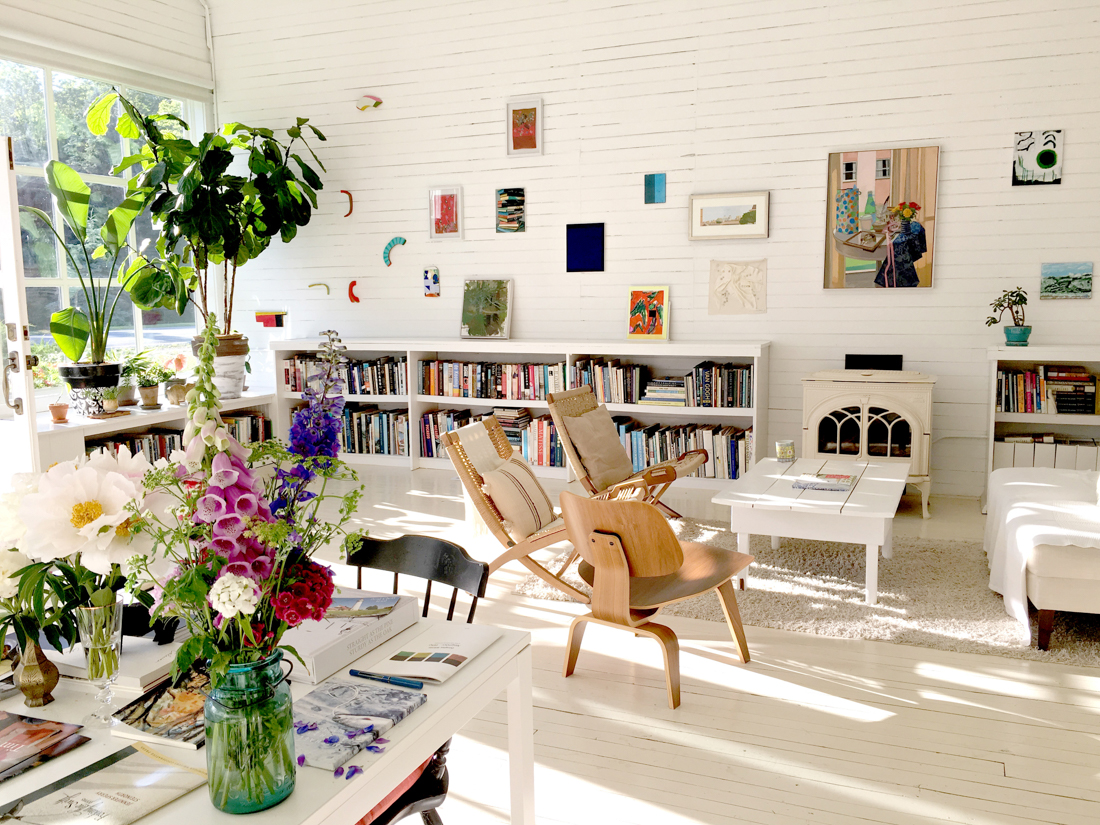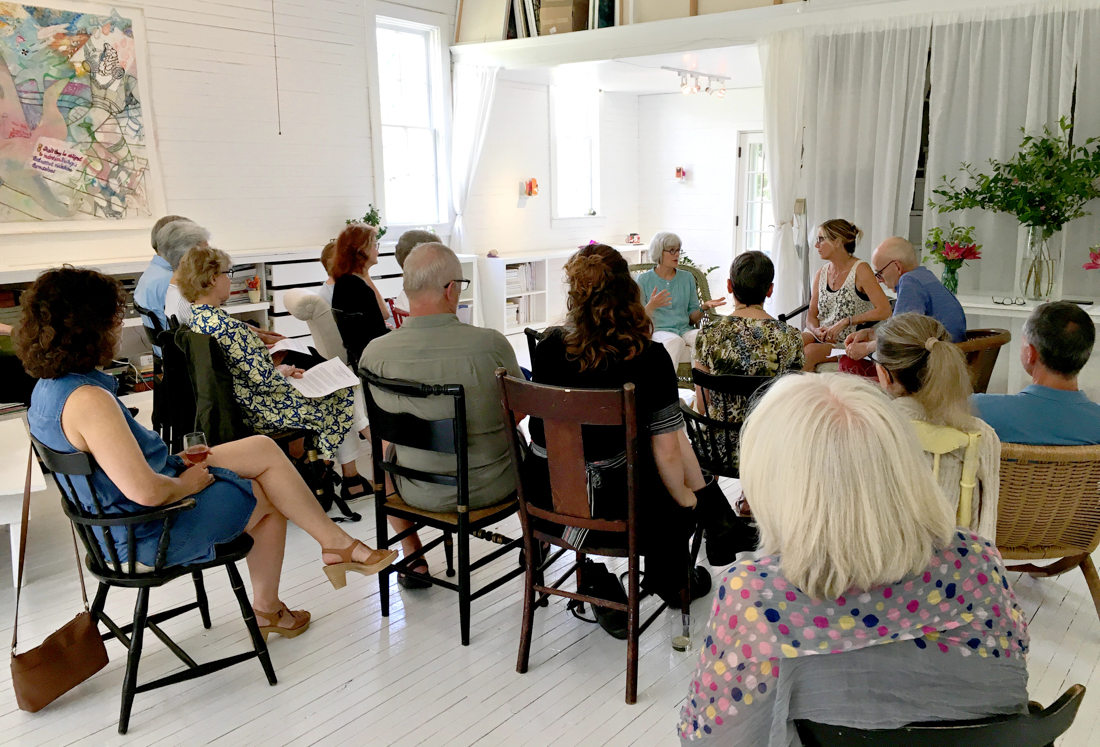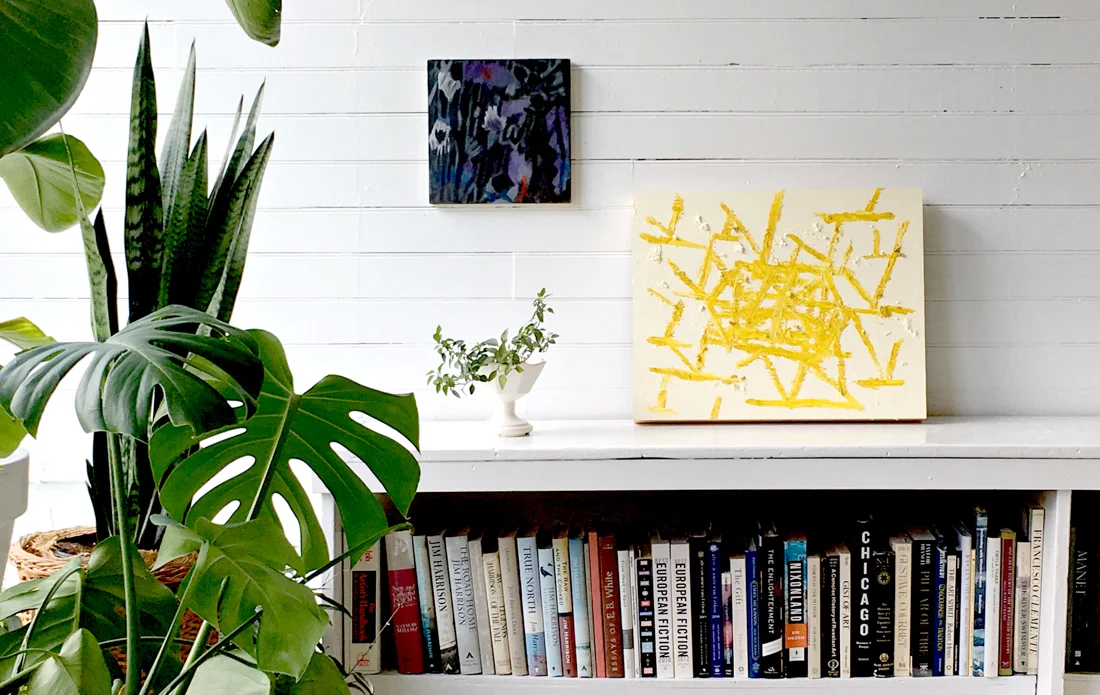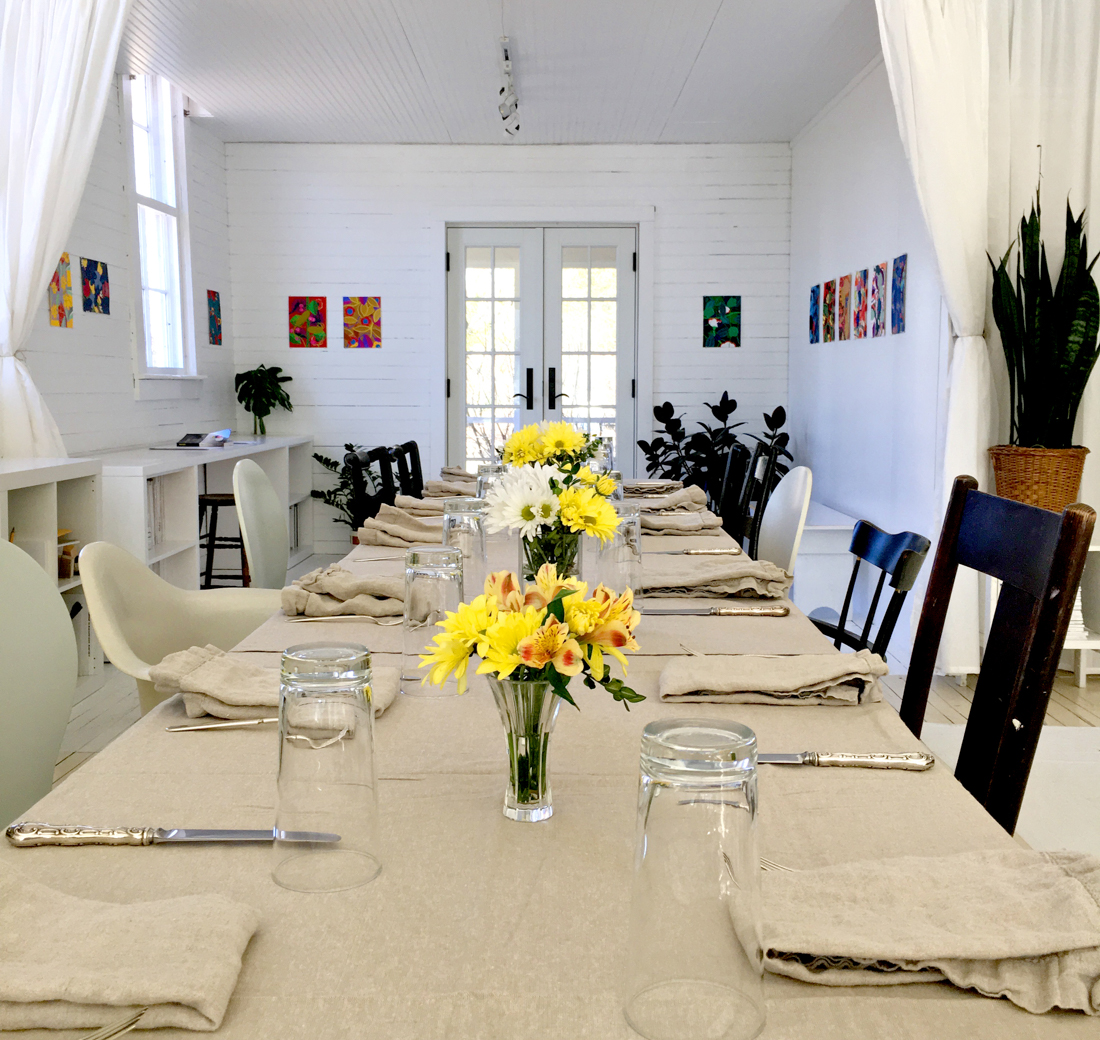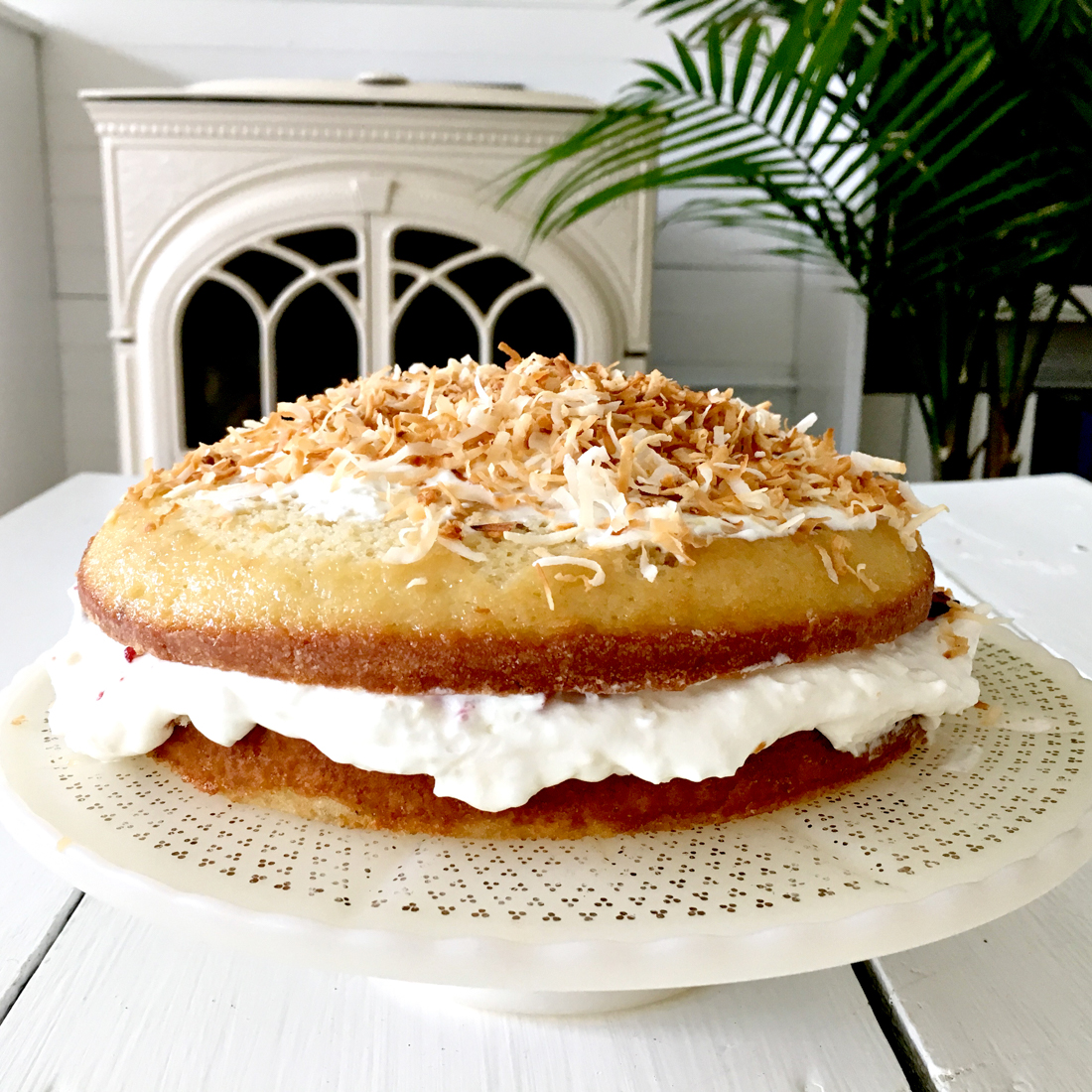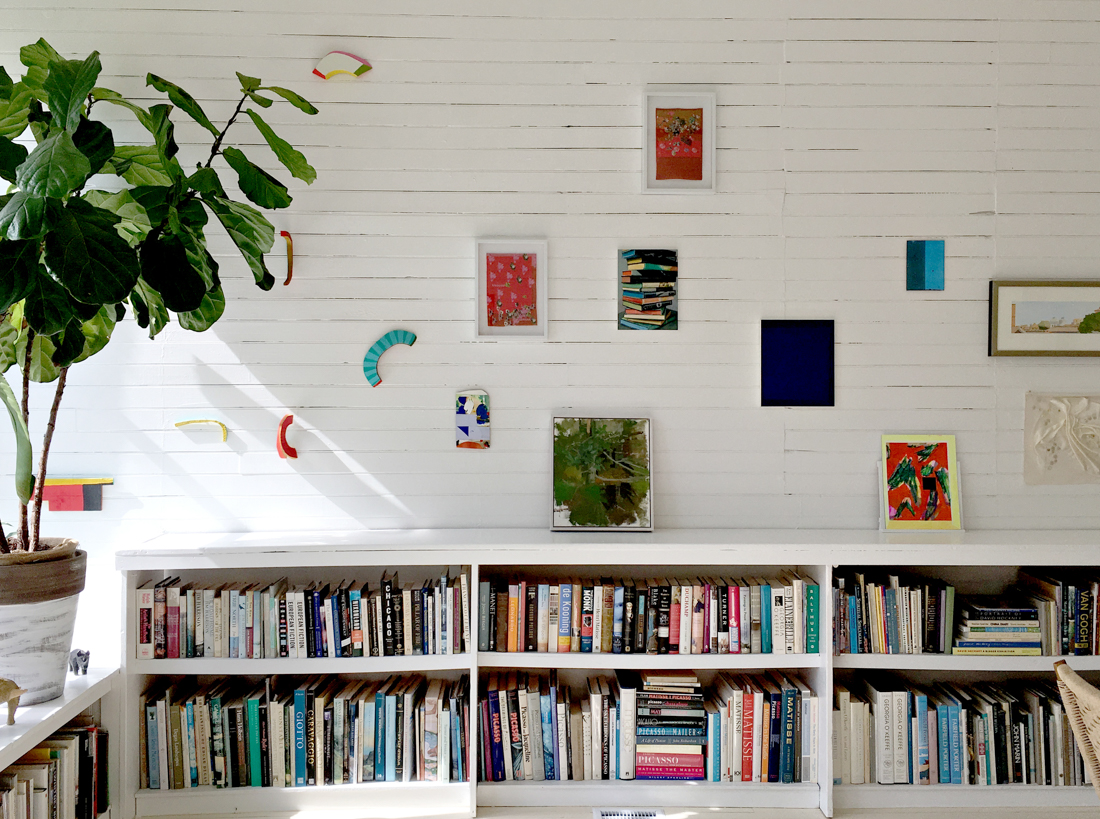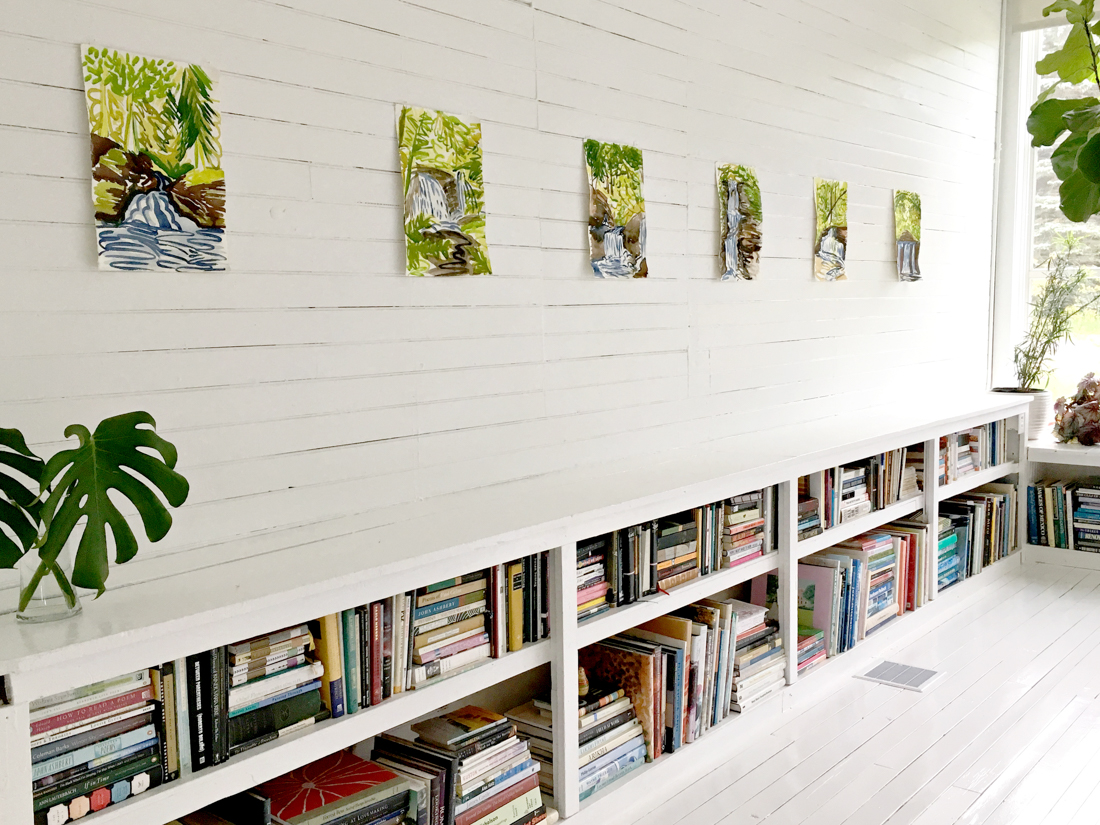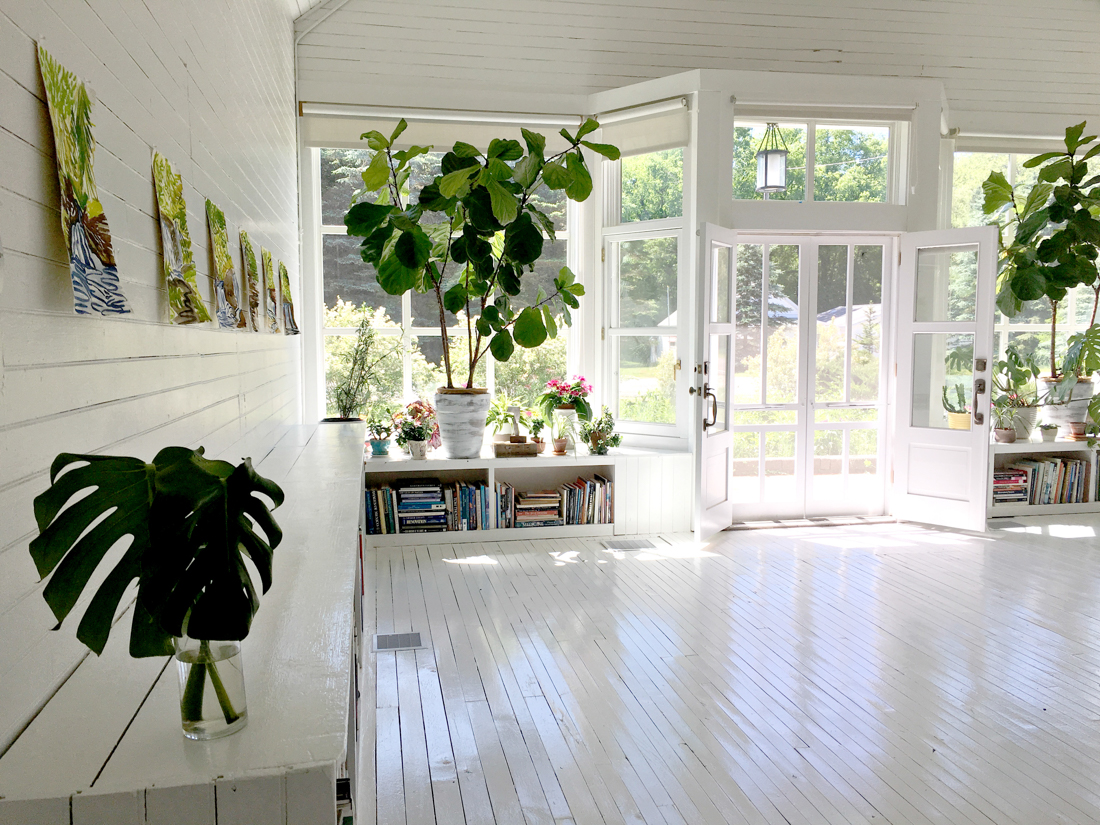The Provincial
The Provincial is a platform dedicated to supporting artists in doing new and experimental work. They host exhibitions, studio visits, visiting artists, performances, occasional dinners and talks. Opening their home and private spaces to the public, guests will find hospitality at the center of what defines them. They offer artists, friends and curious visitors the experience of art in an intimate and welcoming environment. The Provincial is run by artists Melanie Parke and Richard Kooyman.
The Provincial
7325 Chief Road
Kaleva, Michigan 49645
theprovincial.net
@the_provincial
(untacit) with Sam King, Matthew Choberka & Ian Hagarty, August 2017
Pamela Fraser, Natural History, in The drawing Room at The Provincial, April 2018
Interview with The Provincial
with Melanie Parke
Questions by Emily Burns
Hi Melanie! Where is the gallery located on your property and how does it relate to the house or other outbuildings? Is it part of your main residence or studios?
The main building, our 1000 square foot exhibition space, is in the interior of a 116 year old structure built originally as a community building and later adapted to serve as a dry goods store in the 1910’s & 20’s. We have a 7 acre wooded property. It sits on the corner block of an old abandoned railroad town in a poor farming community. We see a lot of tractors go by.
Our small living space, long and narrow, about the size of a trailer, is attached to the main building, probably added as a store keepers quarters in the 1930’s. Also on the land we have my husbands studio and wood shop in a big red barn, a sauna, a vegetable garden, a guest house and my summer studio. It’s all steps away from each other.
The gallery walls have a very unique, painted clapboard surface and painted wood floors. The texture of the walls makes a beautiful backdrop for the work that you show. In particular, tactile, painterly paintings looks particularly lovely against the texture of the painted wood. Is there an aesthetic that you look for when choosing work to show? Is the uniqueness of the space a consideration? Is scale a factor?
I like the look of the walls too. It sets everything that hangs on those walls in relation to a rural history. And like you said an aesthetic, which I think of as warm and friendly and familiar. Are the walls a determining factor for the work is such a good question—I think they hold so much possibility… Because the interior is expansive and floor-to-ceiling white, the space can be both casual and formal. The ceilings are 18 ft. high and the furniture sparse, so when visitors walk in they are surprised how big it is inside. I do enjoy seeing shows relate to the specific walls and bookcases. Peter Shear curated a 13 person show in 2016 where some paintings were hung and some casually rested on the shelf. I liked the way the paintings had a direct relation to the book cases, it seemed to suggest to the viewer: you can pick this up and read it.
You describe the project on Instagram as a hybrid, flex- space—what does this mean to you?
The whole property exists as a mix of private, public, online and real life spaces. Like an apartment gallery, we live here and have highly curated shows too. And it all has to have flexibility in order to work, especially as we are still dreaming up how we can share the resources of this property. How we do this while nurturing our own private painting lives is always in flux.
The main exhibition space is my studio that I gradually turned over completely to shows in the summer. I used to maintain a corner of the space for my studio but this spring Richard built me a separate summer studio, so now the whole space can be utilized for the curatorial program June through August. Just last year we converted a 10’x10’ adjoining storage area into exhibition space that we call the Drawing Room, and we can now host exhibitions there year round.
When did you and Richard establish the gallery? Can you tell us the story of what brought you to the tiny town of Chief, Michigan?
I have been here 21 years. After graduating from SAIC, I decided the best way to try to get good at painting was to paint from life, and I set out to paint the landscape in the romantic lifestyle of Cezanne for two years. So I moved up to our family cottage in Leland, MI and waited tables to survive. I soon learned it would take a lot longer than two years to be a good painter! I fell in love with Lake Michigan and stayed. When our family cottage sold and renting became too problematic for a studio practice, I started looking to buy something. My banker told me I could not afford an outhouse in Leland, a beautiful resort town on the lake, but he could give me a loan for $25,000 if I found something elsewhere. About an hour south in Manistee county, I found this wreck of a place listed for guess how much? $25,000! It was neglected when I bought it, but then I met Richard and he has since touched every surface. You can instantly sense the skill and care he has tended to the upkeep on this needy historic property. I gave the curatorial program it’s name The Provincial, with it’s first proper show in 2015.
What was the impetus to begin the space? What were the first steps to bring the idea to fruition?
The first steps were always there. You walk into the space and have ideas of what you can do here. Since buying the building I have been holding classes, hosting film screenings, house concerts, performances, art shows and dance parties, and maintaining it as a studio for my own work. Living in Chicago taught me a lot about apartment galleries. But working directly with Julie Torres during Bushwick Open Studios cemented the idea to give what we do here a name, a purpose, a vision and a framework. Julie has a way of institutionalizing trust among artists, encouraging artistic agency, and more than anyone else, she has the know-how to curate on a shoe string. Her ethos revived my own commitment to curate.
You and Richard are both painters. Can you tell us about your backgrounds as artists and some of the experiences that led you to this point?
Richard was born and raised by Dutch parents in Holland, Michigan, and is the first generation in his family to attend college. He credits his parents love of making things by hand to becoming a fine craftsman and furniture maker. He was fiercely independent and motivated to be an artist.
I grew up in Indianapolis to a literary family that thrived on nature, curiosity and adventure. I got my BFA at The School of the Art Institute of Chicago. SAIC in the late 80’s was in the throes of challenging the culture wars. Dread Scott was a class mate and friend at the time of his piece called What is the Proper Way to Display the American Flag which was protested by Veterans on campus. This tumultuous time of censorship would form my critical, feminist and political perspective. Coming out of art school as the NEA was dissolving drove me to research other ways the government could support artists. I was waiting tables and painting and going to the library on nights off researching when I came up with the idea to propose artist in residence programs in the National Parks. This was before personal computers so it was a lot of hours typing, which I was never good at, but it paid off. I proposed 30 programs and personally helped initiate 8 of these programs between 1993-1997. It was all volunteer work and it was exciting to see how many artists the program could serve.
Richard was making a living doing the best fine art and craft fair circuit in the booming 80’s. We met when he signed up for my outdoor painting class in 1997, ready to make the switch to painting and get out of a marriage. It took place at Point Betsie Dunes, in Frankfort, Michigan, a historic coast guard community tucked into dramatic dunes on Lake Michigan. Imagine an Edward Hopper painting. It was pretty romantic. We both saw in the other a determination to carve a whole life around art.
What are your goals or mission for the space in the future?
We are dedicated to supporting artists in making new and experimental work. We encourage camaraderie, reciprocality, collaboration, sharing resources and thinking together. We hope to present thoughtful, highly curated shows where our audience can encounter both raw creativity and intellectual verve, critical engagement and risk. We look for ways that regional artists can bond with artists farther a field and visa versa, because we believe friendship and support for artist-driven endeavors can regenerate community, culture and humanity.
In the future I’d like to have the space set up so a guest curator can walk in and have everything at their fingertips to organize and install a show from start to finish as they envision it. Without me. I’d like to get out of the way. When Mary Judge owned Schema Projects in Bushwick, she once gave us the keys to install a four person show while she was out of town. The small space was so efficient, everything we needed was right there, I was so impressed by how she thought of every detail, it’s effectiveness and ease.
How has social media and the internet impacted your work with the space so far?
It’s definitely an important arm that reaches people we have no idea are out there. When Peter Shear organized a show here, he increased our visibility because he has nearly 42 thousand followers on IG. Some of his followers drove up from Grand Rapids to see the show and we have since become good friends and collaborated on projects.
We also have a place on Artsy, which is such a beautiful platform for artwork. I feel like Artsy can expand beyond our remote location and limited real-life visibility.
What are some of the challenges of operating a gallery in such a rural area with so few people in the immediate vicinity? Do people travel to openings and events? Where is the nearest city? Airport? How accessible is the space to the outside world?
The hard part is cultivating an audience closest to home in Manistee County, where all cultural events are lightly attended. The answer seems to lie in getting immersed in the community, going to yoga classes, town meetings, attending the cultural gatherings that do exist. It’s really hard because while we have a close artistic community, it's very spread out. Traverse City and Leelanau County are both an hour away. Some friends drive from Grand Rapids —three hours south, and some come from Chicago—a five hour drive. But isn’t driving long distances the new zen, the new solitude, the one respite away from the phone? Our guests seem to love the adventure of getting here for special events. We usually have about 30–40 really engaged people at our talks and receptions. Being open by appointment allows us to make each visit special to us and the guests, spending concentrated time with each.
Are the exhibitions always curated by guest curators? How do you collaborate with the curators?
No, but many are. I encourage it and I’d like to get to that place eventually, where I hand over everything. My part is setting up what’s possible in the space, the time frame, and administrative supports as in social media and promotion. And an ear to bounce ideas. I assist each artists vision. Every artist has different needs, and some are not able to travel here, so in those cases I curate and install. So far I’ve experienced a strong current of mutuality and respect that flows between me and guest artists, especially other artists who have been involved with artist-runs. They get that the whole thing is dependent on trust and reciprocal energies, and it’s just the best when collaboration is fluid. A magic fuel that lights the fire.
You state that “support for artist-driven endeavors is regenerative to community, culture and humanity.” Can you elaborate on this sentiment and the importance of artist-run projects today?
Yes, I think it’s an amazing moment to be in right now where there are so many artists investing whatever they’ve got, in whatever form, whereever they are, and utilizing their own raw materials to advocate for other artists. It takes on many forms from artist-run spaces all over the globe to roving independent curators to crit clubs to lady painters meeting across the country to support each other. Online projects, occasional events, pop-ups. Projects that embody generosity are vital right now, when we are navigating perpetual daily political dismay. Because they provide models to look to. Models that show us how to center humanity as our core interest. The most important thing to invest in. Antithetical to the burn-out masculine economy, a capitalism that puts profit-worship, individualism, competition and mindless consumption at it’s end-goal, artist- driven projects upend all that. New platforms generate new ways to think, to perceive culture, presentation and content, to share resources, and ultimately share power, and that is where humanity is really felt.
You welcome artists, guest curators, friends and curious visitors with ’rural hospitality’—how do you define this and why is this important to your mission as an artist-run space?
A few years ago I attended a professional development workshop in Chicago on studio visits. When I described to my group that in the country I bake pies and serve tea for my visitors, I was teased for being provincial. The word burned a funny stamp in my mind. When I was thinking of a name for our projects I thought of how Michelle Grabner embraced the suburbs with The Suburban. And the Provincial stuck. I’m fond of homey, welcoming, nurturing experiences. Hospitality is just kindness. Food a way to linger, spend time together, open up conversation, relax, hang out. It’s a unifier and it’s a way to extend time with each other and with art. Guests travel a long way to see us and I recognize it is a special individual who takes time for art. I also love to bake.
You hosted a “Sunday supper” in the gallery on the occasion of Brian Edmonds show—how does food relate to your enthusiasm for hospitality?
Sunday Suppers are a seasonal event that coincide with our winter programing in The Drawing Room. The 10 ft x 10ft north-lit room is now a dedicated space to extend year round shows. Perfect for small intimate presentations. A communal meal centered around a show like Brian’s is a way to extend affection and care, which is at the root meaning of to curate, to care for and cure. I love this mission.
The Sunday Suppers bring together artist friends and patrons who appreciate close looking and deeper conversations, which can be hard to attain at an opening. Winter here can feel especially isolated and desolate, and I think we have a real hunger to get a dose of intelligence and visual pleasure. We hope the Sunday Supers can serve some of these needs.
It seems like you uniquely straddle two worlds—bringing in artists and curators to your home, your events and programming likely have an incredibly intimate and personal element to them, while being somewhat isolated makes an online and social media presence necessary to stay connected. Can you talk a bit about balancing the in-between-ness of this? Is this something you experience?
Yes. My husband and I have personality types that get overwhelmed by repetitive socializing, so it is a concern we spend a lot of time troubleshooting. How do we protect our privacy, our own painting practice, our happy quiet marriage, and put it all out there at the same time? I think the solitude and remoteness of our location helps set up the perfect protection. When we have the occasional visits we are thrilled by the company and open up our private spaces to share the exhibitions, our art collection, our studios and the grounds, in a way to illuminate how it is all connected.
I love having this peaceful home with all the internet has to offer too. Attending to relationships online is a great vehicle for sharing ideas through writing and communication. When I get overwhelmed, I turn off the news and am regenerated by my friendships, nature, my studio practice and intellectual activity.
How do these ultra-personal experiences relate to you goals for the space?
Many artists say that curating and organizing artist-runs is an extension of their own studio practice, and I identify with this too. I relate to this idea of flow, of applying the principles of interdependence to a whole life. I’ve long admired the Bloomsbury group and aspired to create a place where an entire way of life is devoted to a creative pursuit while at the same time extends beyond itself into support and enthusiasm for others creative work.
You have a guest house on the premises, is an artist residency a part of the program?
Richard and I think of the Guest House as an extension of The Provincial, as a platform to support artists and thinkers in new and experimental work. We hope it can provide a place of respite for both friends and artists. It is our desire for it to be cost free and demand free.
We decided to emphasize it as a guest house rather than a residency to avoid adding heavy administrative roles to our already busy careers. It can be used like a homespun, self directed residency, or it can be a place to rest and do nothing. It works best for us as a word of mouth thing. On trust and good will, where friends of friends connect each other. We have framed it so everyone is independent and does their own thing.
Any exciting news in the near future? Whats up next at the space?
Yes! Phantom Shell opens in late July with Catherine Haggarty and Anna Valdez. They will be visiting from Brooklyn, NY and Oakland, California and giving talks about their vibrant work. We also have Will Higgins, an artist and journalist from Indianapolis, who will be recreating a 1977 vendor booth from the American Society of Presidential Urine Collectors Annual Convention in Las Vegas, Nevada.
Thank you so much for talking with us!
To find out more about The Provincial, check out their website.



